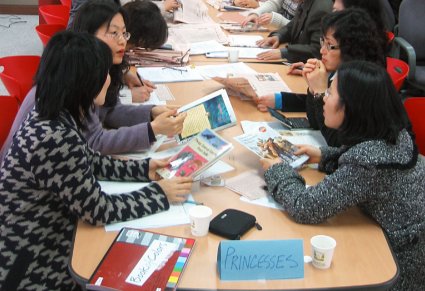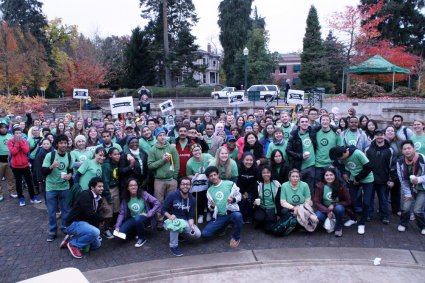 EUGENE, Ore. — (March 27, 2014) — The University of Oregon, through a cooperative agreement with the U.S. Department of State and in partnership with Coursera, enters the MOOC world April 7 with the launch of a free, two-part Massive Open Online Course designed to help educators more effectively teach English as a foreign language.
EUGENE, Ore. — (March 27, 2014) — The University of Oregon, through a cooperative agreement with the U.S. Department of State and in partnership with Coursera, enters the MOOC world April 7 with the launch of a free, two-part Massive Open Online Course designed to help educators more effectively teach English as a foreign language.
The course, "Shaping the Way We Teach English," targets educators looking to pursue English instruction as a career as well as those already in the field who may wish to refresh their teaching methods and approaches, said Leslie Opp-Beckman, director of eLearning in the UO's American English Institute, a program of the Department of Linguistics.
"This course allows educators anywhere to sign up for free and learn English-teaching strategies from top-ranked university faculty," said Opp-Beckman, who has worked for more than a decade developing the framework through a series of cooperative agreements with the Office of English Language Programs of the U.S. Department of State's Bureau of Educational and Cultural Affairs. "Participants will find themselves in a unique, multimedia-rich collaborative environment that allows them to interact with English-language educators from all over the world."
 The course is the first MOOC to formally emerge from the UO. It features two five-week courses that are being announced this week in Portland, Ore., during the TESOL (Teaching English to Speakers of Other Languages) 2014 International Convention and English Language Expo "ELT for the Next Generation."
The course is the first MOOC to formally emerge from the UO. It features two five-week courses that are being announced this week in Portland, Ore., during the TESOL (Teaching English to Speakers of Other Languages) 2014 International Convention and English Language Expo "ELT for the Next Generation."
The first course explores the landscape and fundamentals of teaching English. The second helps participants chart a path to success. The two components stress the importance of working with individual learning differences and promoting collaborative approaches that foster active participation by students. The two units can be taken simultaneously or separately, in any order. Initially, however, the first part begins April 7 and the second part will first launch May 12.
Deborah Healey, Jeff Magoto and Elizabeth Hanson-Smith of the UO's American English Institute, who helped develop the course, are instructors for both parts. Students who successfully complete the class will receive a "Statement of Accomplishment" from the U.S. Department of State and the UO.
VIDEO: 5-minute introduction to "Shaping the Way We Teach English"
The UO's Innovation Partnership Services, part of the Office of Research, Innovation and Graduate Education (RIGE), worked with Coursera, an educational technology company that partners with top universities and organizations worldwide to offer free online courses, on an agreement to make "Shaping the Way We Teach English" available.
"RIGE is excited to see the American English Institute's work with the U.S. Department of State over many years now extending through new channels, such as Coursera, to deliver 'Shaping the Way We Teach English' to the next generation of English-language learners," said Charles R. Williams, assistant vice president for innovation.
About the University of Oregon
The University of Oregon is among the 108 institutions chosen from 4,633 U.S. universities for top-tier designation of "Very High Research Activity" in the 2010 Carnegie Classification of Institutions of Higher Education. The UO also is one of two Pacific Northwest members of the Association of American Universities.
Media Contact: Jim Barlow, director of science and research communications, 541-346-3481, jebarlow@uoregon.edu
Source: Leslie Opp-Beckman, director of eLearning, American English Institute, 541-346-3945, leslieob@uoregon.edu
Note: The University of Oregon is equipped with an on-campus television studio with a point-of-origin Vyvx connection, which provides broadcast-quality video to networks worldwide via fiber optic network. In addition, there is video access to satellite uplink, and audio access to an ISDN codec for broadcast-quality radio interviews.